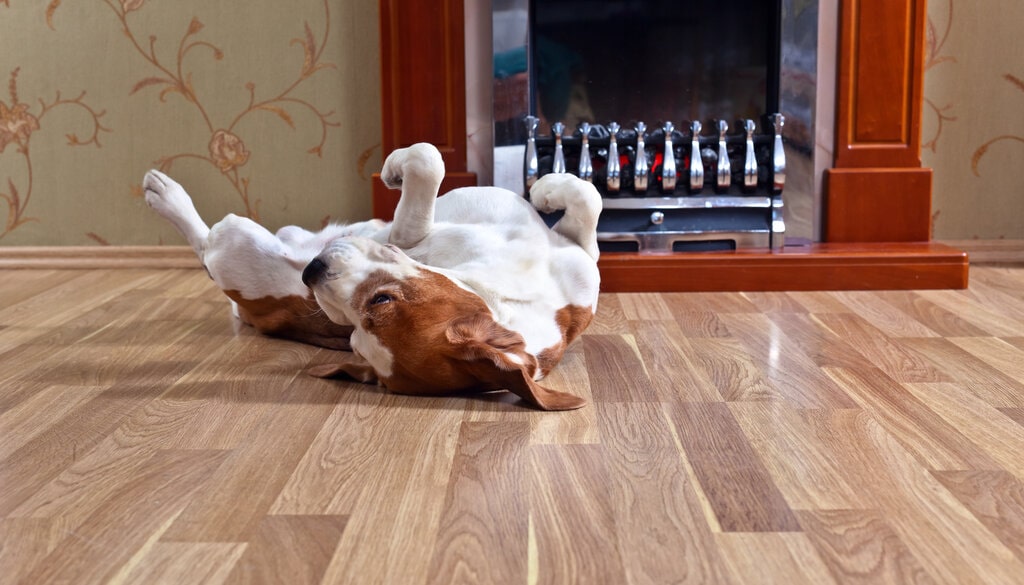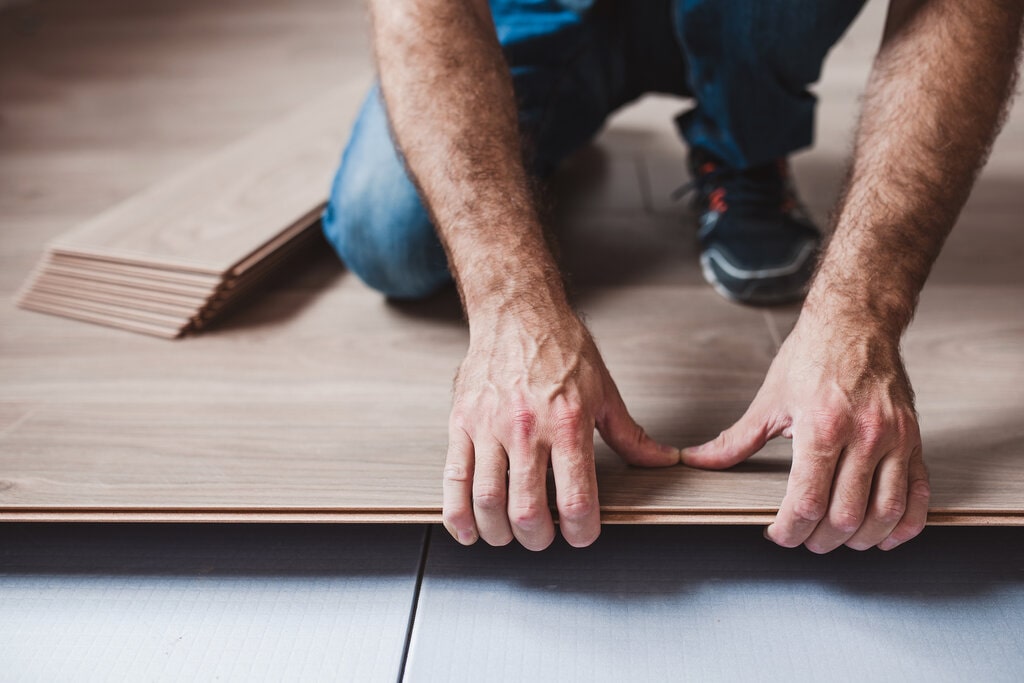
Every beautiful room starts with a charming floor, and there is something so timeless and perfect about wood floors. They are the foundation of your home and should be installed properly. It’s no wonder that installing a floating floor is still a popular trend in 2021, and one of the easiest and most effective methods of installing floors, from engineered hardwood, to laminates, even luxury vinyl floors.
Many of you might have heard the phrase: “installing floating floor”. Well, that is not entirely correct, as floating floors are not a specific kind of material for flooring but rather a method of installation.
What is a floating floor, and is it still used in 2021?
A floating floor is a flooring installation that does not require the use of nails. Instead of nailing down wood planks, you attach them by snapping them together like a puzzle. So, the floor is more or less “floating” over the substrate rather than being firmly attached to it.
The floating floorboards make installation fast, simple, and efficient budget-wise. This method works for various floor materials, from plywood to concrete, sheet vinyl or even porcelain tiles.
However, as you would imagine, a floating floor could feel a bit hollow under your feet if not installed correctly, or the subfloor is not prepared in advance.
Engineered wood flooring is one of the best available wood flooring materials installed as floating floors. Layers of wood veneer glued to layers of plywood are very stable and look like solid flooring.
Historically, we would attach the floor to the subfloors. Ceramic and porcelain tiles would be mortared to the base, and hardwood floors would be nailed down to the subfloor.
As DIY installations gained popularity, new methods had to be developed to make the whole process easier, free from automatic or manual nailing.
Is a floating floor a good option?
A floating floor is a good option if you are on a tight budget or into DIY. Historically, floating laminate flooring was the first in line for this method, but it has quickly spread to several other materials.
A floating floor is essentially made of unique planks that click into place, like in a puzzle. That makes them ideal for installing over old floors. For example, you have an old, ragged hardwood floor that needs heavy repairs; you can cover it up with a floating wood floor until you’re ready to mend it.

What is more, floating timber floors are non-invasive; they do not damage the subfloors. Thanks to their click-lock technique, they can be re-used. They are also perfect for floor heating systems, making them more efficient and easier to install.
The main advantages of a floating floor installation
- It is less expensive than the traditional methods
Floating engineered hardwood or any other type of “floating” material is usually less costly to install. In the last year and a half, confined to their homes by the Coronavirus pandemic, many people turned to DIY activities around the house.
Floating floors can be an excellent remodelling idea if you want to do it yourself. They can generally be laid down fast, and they don’t require any adhesive material or nails.
- DIY-friendly
Yes, exactly. You can start with a room or with the basement and exercise your newly DIY skills, and then you can extend to the whole house.
This installation method allows the floor to move and expand in response to changes in the room air conditions (temperature and humidity). More than that, in the basement, you can install it over the concrete subfloor
- Variety and versatility
It is available in various materials and types, from floating tile floor to floating hardwood floor.
- The installation process is eco-friendly
It uses less wood, fewer materials, no adhesive, no nails—just you, with a bunch of click-lock or tongue-and-groove planks of wood or tiles. If you feel overwhelmed, you can call on a handyman to help you.

Floating floor disadvantages
- You might need to replace them more frequently
First of all, the floor is thinner. Second, it rests on the subfloor and a tiny bit of air; that’s why it might also feel a bit hollow under your feet. Some of your daily activities might have a damaging impact on it.
For example, as you all work from home during these times, rolling your office chair across the floating floor might result in signs of wear more quickly than you would expect.
Of course, overall, it depends on the type of traffic that your floors get daily. If it’s just you two working from home, that might not be a problem. However, if you’ve got kids, visitors, pets walking around, thumping and running around, the floating floors might not resist all that for too long.
- They may lower the real estate value of your property
Yes, they are easy to install, easy to take off and easy to DIY. However, they are not very popular on the real estate market and are still deemed cheap when added to the value of a house. So, if you are planning on selling your property soon, it might be a good idea to avoid this type of floor.
Hands down, floating floors command lower resale value than other traditional nailed down floors.
- You cannot refurbish them
Floating floors cannot be sanded and refurbished like solid floors. Extreme and frequent changes in moisture and temperature can cause the flooring to expand and contract and, finally, over time, can damage the floor.
Most common floating floor types
As we were saying initially, the floating floor is quite versatile and works with many materials. However, there are three main types of flooring that are popular for this method.
- Laminate flooring
Floating laminate flooring is probably the first type of floating floor. It can contract and expand without buckling as a response to the humidity in a room. The planks are usually coupled together along the edges in a click-lock or fold-and-lock system.
- Luxury vinyl flooring (LVF)
You can snap them together board-to-board without glue. Nevertheless, some might require a certain type of adhesive to attach to the subfloor. The vinyl planks are usually semi-flexible, and they lock together with the help of the tiny tongues and grooves on each edge.
- Engineered wood
Engineered wood is traditionally installed by nailing it down to a plywood subfloor. However, if you want to save money and make things simpler, you can choose floating engineered hardwood.
Frequently Asked Questions About Floating Floors
Now that we covered most of the basics of floating floor installation, let’s answer some of your concerns about the practicability and durability of floating floors. You saw what the disadvantages are, as well as the advantages. However, let’s dive deeper.
- Is a floating floor waterproof?
Floating floor installation, as a method, does not guarantee impermeability. However, given that floating floors are usually synonymous with laminate floors, we could discuss the waterproofness of laminate flooring for a bit.
When adequately sealed, laminate floors can withstand spills and splashes and offer excellent durability in time. However, they are not waterproof by definition; let’s not forget that they are made of recycled hardwood.
Vinyl flooring is very good at resisting water and moisture naturally.
- Can a floating floor go over tiles?
If the tiles are not cracked or loose, yes, you can lay floating floorboards over them. This way, you will gain a considerable floor height, so be careful about doors and appliances.
Actually, you should ask yourself if it’s even worth it. Why do you really want to do that?
- Can a floating floor go under appliances?
Yes, you can place appliances like a refrigerator or dishwasher, on floating floors. It’s true, that’s a lot of weight there, and that’s why you need a particular floating floor specially designed for kitchens, and that type of weight.
Nevertheless, even with hardwood floors, you should consider moving the furniture around once in 2-3 years to even out the pressure on the flooring. It’s not that bad of an idea; it also gives you a cause for redecorating and refreshing your interiors.
- Does a floating floor settle
Yes, floating floors will settle in time. Don’t worry about it. If they don’t, it means they haven’t been laid out correctly, and you should re-do it.
However, please note that there is a slight difference between a nailed hardwood floor and a floating one. You will always feel a certain amount of movement as you walk over a floating floor. You will get used to it and won’t even feel it with time. Don’t worry about that.
If you have any further questions regarding floating floor installation or looking for advice about your home’s best flooring options, feel free to contact the ESB sales team. Contact us now to request your hassle-free, no-obligation free samples or come down to our North London showroom for a closer look.
Pictures: Pinterest
| Mon-Fri | 8:00AM – 5:00PM |
| Saturday | 10:00AM – 4:00PM |
| Sunday | 11:00AM – 3:00PM |





.svg)
.svg)